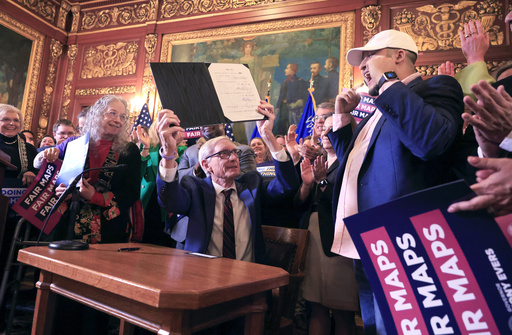MADISON, Wis. (AP) — Wisconsin Democratic Gov. Tony Evers signed new legislative district maps into law on Monday that he proposed and that the Republicans who control the Legislature passed to avoid having the liberal-controlled state Supreme Court draw the lines.
Democrats hailed the signing as a major political victory in the swing state where the Legislature has been firmly under Republican control for more than a decade, even as Democrats have won 14 of the past 17 statewide elections.
“When I promised I wanted fair maps — not maps that are better for one party or another, including my own — I damn well meant it,” Evers said prior to signing the maps into law at the state Capitol. “Wisconsin is not a red state or a blue state — we’re a purple state, and I believe our maps should reflect that basic fact.
Democrats are almost certain to gain seats in the state Assembly and state Senate under the new maps, which will be in place for the November election. Republicans have been operating since 2011 under maps they drew that were recognized as among the most gerrymandered in the country.
Democrats tried unsuccessfully for more than a decade to overturn the Republican-drawn maps. But it wasn’t until control of the state Supreme Court flipped in August after the election of liberal Justice Janet Protasiewicz that Democrats found a winning formula.
They filed a lawsuit the day after Protasiewicz joined the court. Republicans argued that Protasiewicz shouldn’t hear the lawsuit because she said during her campaign that the GOP-drawn maps were “rigged” and “unfair.” But she did not recuse herself.
Protasiewicz ended up providing the deciding fourth vote in a December ruling that declared the current maps to be unconstitutional because not all of the districts were contiguous, meaning some areas were geographically disconnected from the rest of the district. The court said it would draw the lines if the Legislature couldn’t pass maps that Evers would sign.
The court accepted maps from the governor, Democratic and Republican lawmakers, as well as three other parties to the redistricting lawsuit. Consultants hired by the court determined that maps submitted by the Legislature and a conservative law firm were “partisan gerrymanders,” leaving the court with four Democratic-drawn maps to choose from.
Facing a mid-March deadline from the state elections commission for new maps to be in place, the Legislature on Tuesday passed the Evers maps. While skeptical Democrats voted against the governor’s plans, many of the party’s leaders praised Evers’ signing of the new maps Monday.
“Wisconsin will no longer be among the most gerrymandered states in the nation,” Assembly Democratic Leader Greta Neubauer said in a statement. Neubauer, who voted against the maps, added that “this is the beginning of a new era in Wisconsin — where the will of the people will once again be the law of the land.”
Senate Democratic Leader Dianne Hesselbein said in a statement that the new maps are “a huge win for the people of Wisconsin” — even though she voted against the maps.
Wisconsin Democratic Party Chairman Ben Wikler said the new maps will have a “reverse coattails” effect benefitting Democrats in the statewide presidential and U.S. Senate races this year because more legislative races will be competitive.
Republicans described having no better option. Republican Assembly Speaker Robin Vos said Monday in a statement that Evers “signed the most Republican-leaning maps out of all the Democrat-gerrymandered maps being considered by the Wisconsin Supreme Court.”
“This fall Republicans will prove that we can win on any maps because we have the better policy ideas for the State of Wisconsin,” said Vos.
Other Republicans were even more stark after the passage of the bill last week.
“Republicans were not stuck between a rock and hard place,” Republican state Sen. Van Wanggaard said in a statement. “It was a matter of choosing to be stabbed, shot, poisoned or led to the guillotine. We chose to be stabbed, so we can live to fight another day.”
Democrats also raised concerns that under the bill, the maps wouldn’t take effect immediately. That raises a legal question for any special or recall elections that take place before November, given that the state Supreme Court already ruled that the old maps are unconstitutional.
Evers said Monday that “these maps will take effect immediately after publication and will be in place for the fall elections.” He also asked the state Supreme Court to clarify that the maps will be in effect for any special elections prior to the November election.
Under the new maps, there would be 15 incumbents in the Assembly who would be forced to run against another incumbent and six such pairings in the Senate. Only one of the Assembly pairings would pit one Democratic incumbent against another one. In the Senate, the only Democratic pairing includes an incumbent who has already decided not to run this fall.
Litigation continues in more than a dozen states over U.S. House and state legislative districts that were enacted after the 2020 census.
The Wisconsin Supreme Court also has been asked by Democrats to take up a challenge to the state’s congressional district lines. The lawsuit argues the court’s decision to order new state legislative maps opens the door to challenging the congressional map. Republicans hold six of the state’s eight congressional seats.
___
Associated Press writer Joey Cappelletti in Lansing, Michigan, contributed to this report.
This website uses cookies so that we can provide you with the best user experience possible. Cookie information is stored in your browser and performs functions such as recognising you when you return to our website and helping our team to understand which sections of the website you find most interesting and useful.
